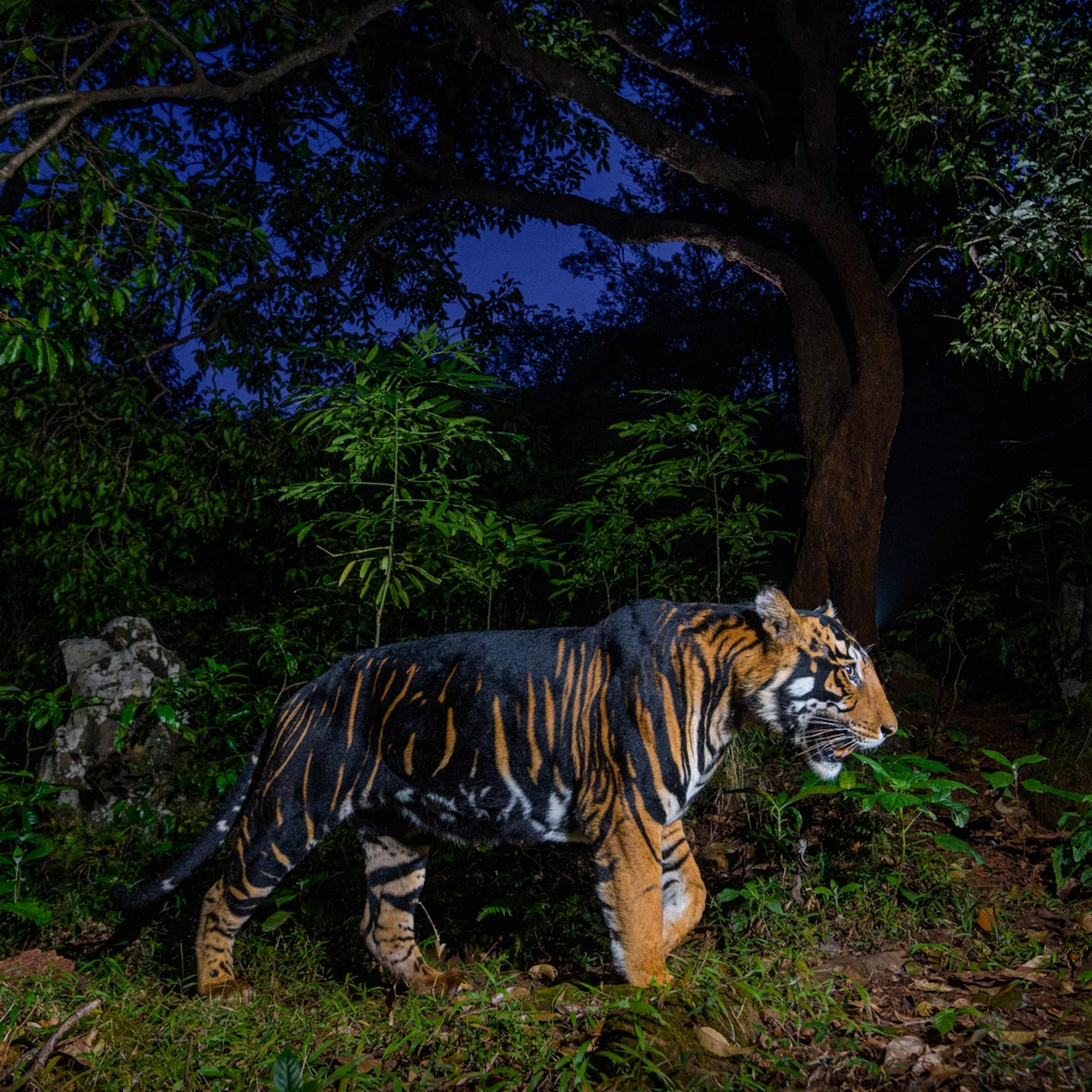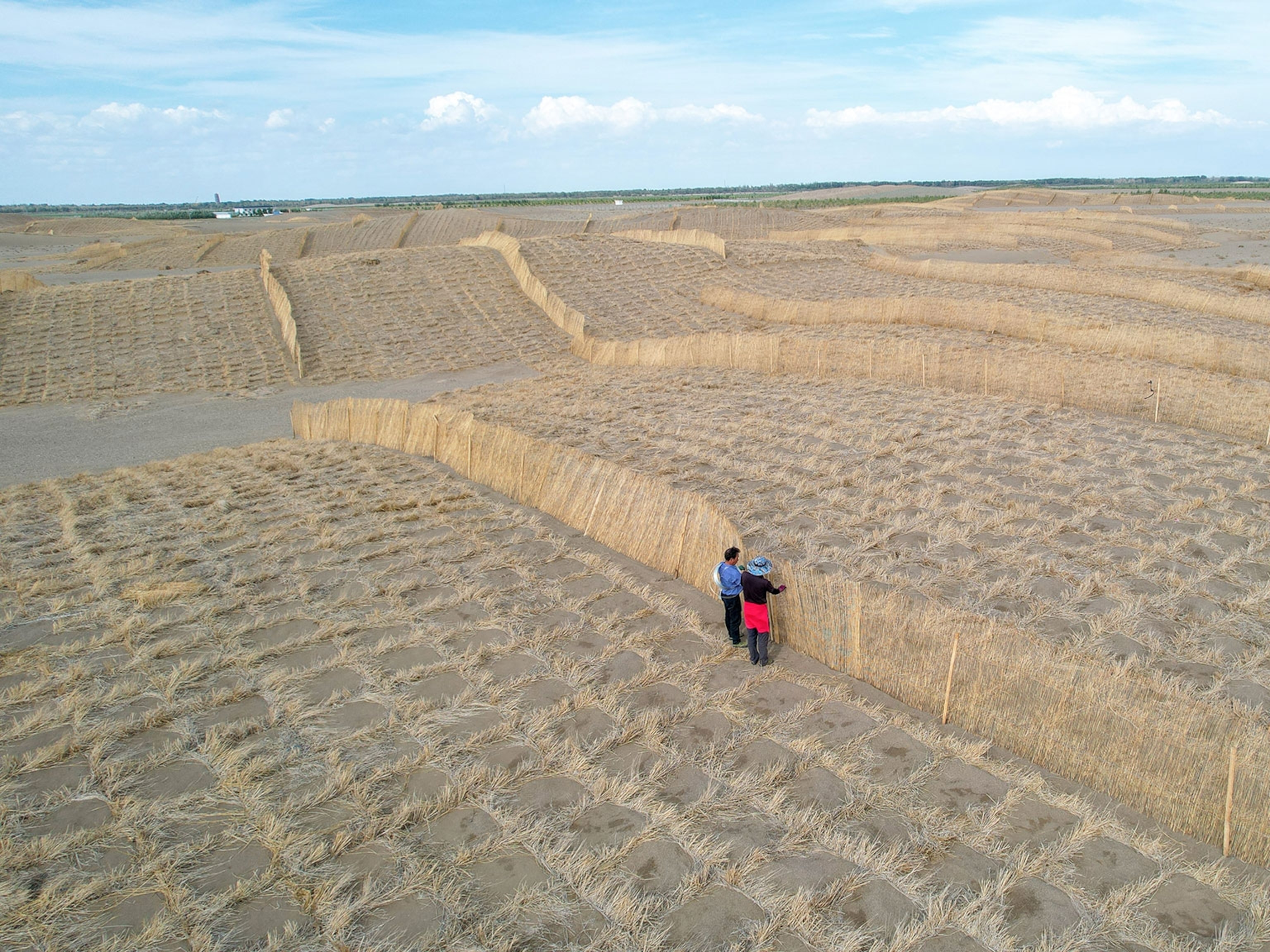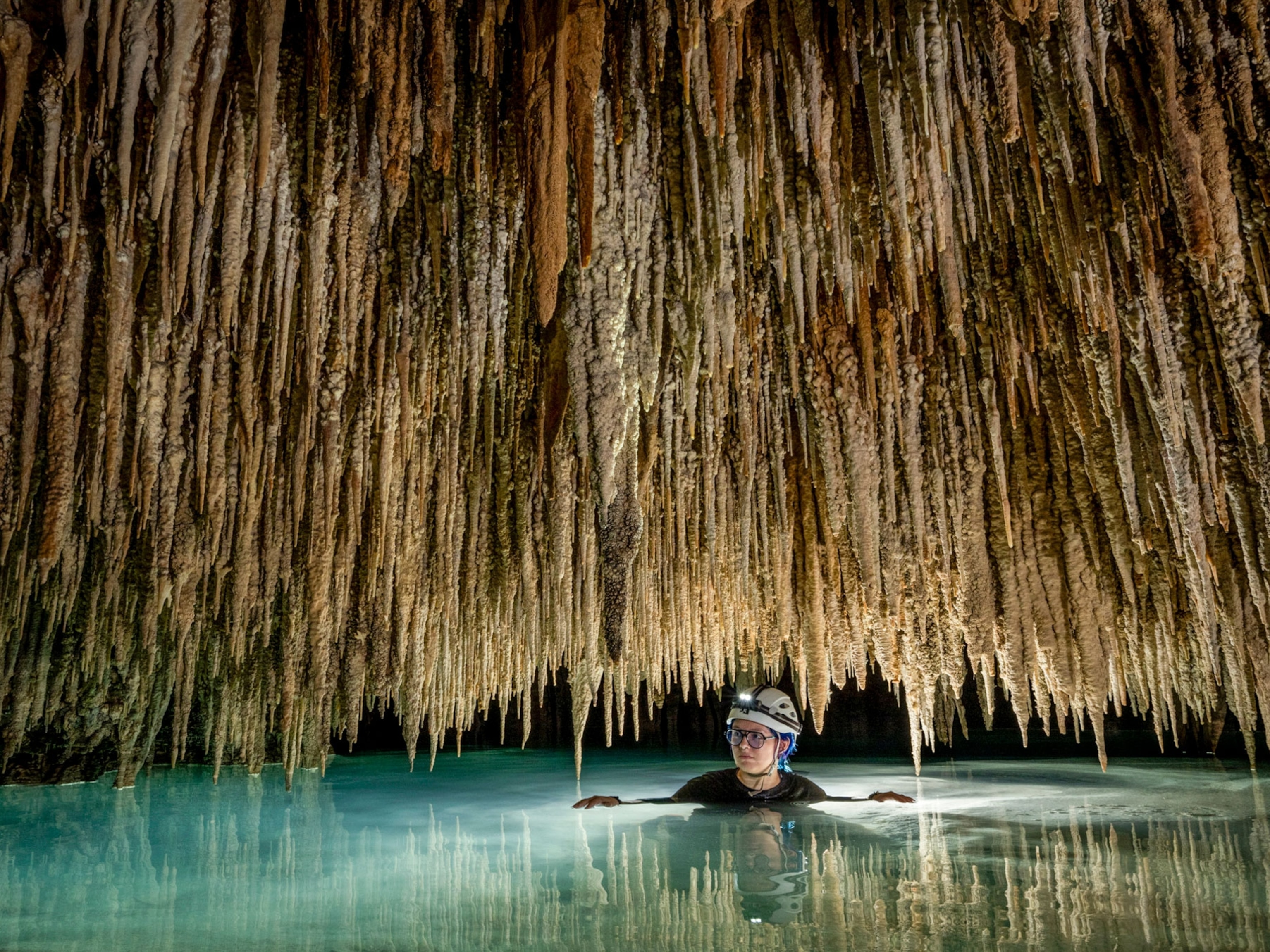
Guam's ecological fate is in the hands of the U.S. military
As the Department of Defense pursues a major base expansion, conservationists and local people sound the alarm about endangered species.
Guam — It was about 8 p.m. and under total darkness. I was standing with a group of eight scientists and volunteers in the middle of the forest, sweating from the humidity and peering into the dense tree branches with a headlight that was making my forehead even hotter. A snake biologist standing next to me called out, “There’s one!”
She had spotted the thing we had come to find: a brown tree snake. The animal is an invasive species brought to Guam in the 1940s, probably by the U.S. military. It’s a rapacious nocturnal feeder that, just a few decades after it was introduced, had eaten so many of the eggs of the native bird populations that 10 of the 12 species went functionally extinct. By some estimates, there are 2 million brown tree snakes on Guam, about 9,500 per square mile.
Scientists, Congress, local residents—everybody wants them gone. One of the volunteers in my outing, a member of the United States Department of Agriculture rapid response team created specifically to get rid of those snakes, collected the two serpents we found in an hour’s worth of searching. After weighing and measuring them, he put them both in a cloth sack, to be euthanized back at the lab (though, usefully, he explained how we should kill them on the spot should we encounter others on our own).
The biodiversity you might expect on a tropical island has been reduced thanks to invasive species like the brown tree snake, plus feral pigs and deer, and compounded by habitat destruction. Those interested in rehabilitating Guam’s ecology need the help of a perhaps surprising ally: the U.S. Department of Defense (DoD). But an alliance with an often opaque organization—and one that has, over decades, soured relationships with some local communities—can be tenuous. Now, as the U.S. military is building up its facilities on Guam and destroying even more forest in the process, this relationship has never been more important—or more tense.
“The future of the island and the people here is decided by the Pentagon, not the people of Guam,” says Dave Lotz, a local historian who has lived on Guam since 1970.
The U.S. military’s complicated history on Guam
“Oh, wow, that really is in the middle of nowhere.” That’s the universal reaction when I tell my friends on the mainland to look up Guam on a map, to find the little fleck of land in the blue expanse of the Pacific. The 212-square-mile island, about 1,600 miles due east of Manila, is surrounded by even smaller tracts of land that together make up the Mariana Islands. The island may be isolated, but it has a long history of colonial conquest. The Spanish came in 1668, the Japanese in 1941, the Americans in 1898 and again in 1944, after defeating the Japanese. Today, its 160,000 residents, 37 percent of which identify as native Chamorros, are U.S. citizens. Though, because Guam is a U.S. territory, people who live there aren’t represented in Congress and the federal government doesn’t count their votes in national elections.
Because they are often so far from other land masses, islands may seem like they’d be less likely to see the ecological effects of introduced species. But in fact, their carefully calibrated ecosystems are more sensitive. Guam has proven to be no exception. With no more birds to disperse plant seeds, the forest has become more vulnerable to disruption. Native limestone forest, the oldest forest on the island where native tree species plunge their roots almost directly into the hard limestone, has been reduced to about 10 percent of the island, according to a 2017 assessment from the U.S. Fish and Wildlife Service.
“Ecologically, Guam is an important place,” says Haldre Rogers, an ecology and biology professor at Iowa State University who studies the Mariana Islands. “Other places in the world have had a lot of extinctions. But few have had full extinctions and no replacement of anything else.”
Here’s where the U.S. military comes in. The DoD holds about 30 percent of Guam’s land, on which it’s built two bases—Naval Base Guam and Andersen Air Force Base. The land the military hasn’t built on remains largely unperturbed, acting as an informal nature reserve as much of the rest of the island has been turned into roads, houses, schools, and hotels (tourism is the island’s second biggest industry, after military spending).
But many locals remain skeptical of the military. After World War II, the U.S. military seized ancestral lands from Chamorros, offering them compensation that locals deemed insufficient (if they received any at all).
“There's a long distrust that has built up over the past 80 years that’s hard to get rid of,” says Rogers, who has lived on and off on Guam for 15 years and who let me stay in her field house when I visited in November. “You can't overcome that in a year of goodwill. It's going to take a long time for people to trust that the military has their best interest at heart.”
“People were thankful to the United States for liberating them from the extremely brutal Japanese [in 1944]. The United States took extreme advantage of that,” Lotz says. “Below the surface, there's resentment that lingers in the local people.”
Not everyone on Guam resents the military, of course. Many locals believe its presence has bolstered the economy, creating new jobs in construction, retail, and service industries. Guam has a high proportion of veterans in addition to the active duty members on the military bases; people from Guam enlist in the military at a higher rate per capita than in any U.S. state. People on Guam have a deep sense of patriotism that’s more palpable than in many places on the mainland. Lotz adds that some locals fear that if the military doesn’t feel wanted, it might pull out from the island, throwing its economy into turmoil.
A “one for one” plan
During my five-day visit, I had a privilege most locals do not: I walked through forest owned by Andersen Air Force Base. It wasn’t, as Rogers calls it, “good” limestone forest. It was secondary forest, made up mostly of non-native species that had taken root once the banana plantation that used to be there was cleared. Butterflies flapped ephemerally in the open areas under the canopy; we wheeled around the serrated leaves of screw pines to see where the DoD’s botanist pointed out spindly worm orchids, clusters of leaves strung together up a tree trunk like Christmas lights.
The forest wasn’t in particularly good shape—there were glass bottles that looked to be from the 1950s scattered on the red soil. But it wasn’t supposed to be. This was forest slated for “enhancement,” a conservation technique that the Navy developed in partnership with the U.S. Fish and Wildlife Service, as is required by the Endangered Species Act, says Albert Borja, the Environmental Resource Manager for Marine Corps Activity Guam. As part of that plan, for every acre the DoD razes for new construction, it must “enhance” another acre.
The military works hard to highlight its efforts in environmental stewardship. It releases videos and publishes websites about its projects to conserve and rehabilitate endangered species like sea turtles, corals, orchids, the native Sali bird, and the last remaining native Serianthes tree, none of which had more than 200 views at the time of publication (they even made a video about my group’s outing to the forest enhancement area, which I was asked to be in because I had come from so far). It allows traditional medicinal healers to enter the forests to forage for the plants they need. Rogers says she knows and respects several biologists who work for the DoD.
But in contrast is a public firestorm surrounding the military’s latest project on Guam. In 2015, the DoD announced it would begin construction of a long-rumored Marine base there (it was planning to close the Marine base in Okinawa, Japan, so a new base on Guam would keep Marines in the Pacific). The facilities that could house and train more than 5,000 Marines and their families are slated to occupy more than 2,000 acres.
On such a small island, construction on that scale is likely to have some profound ecological effects, critics say. After years of (legally required) research into exactly what those effects would be, the final plans involve bulldozing some 1,000 acres of the island’s remaining native limestone forest as well as several sites significant to the Chamorro. That's about 8 percent of the remaining limestone forest according to a 2017 Fish and Wildlife report. Much of the forest surrounding that last remaining Serianthes tree will be cleared for a live firing range; the Serianthes will be left standing, with a 100-foot buffer of forest on each side, plus some fencing, to protect it from bullets. Yet locals expressed concern that the lead from the bullets in the range could contaminate the aquifer that provides drinking water to the entire island.
Before the final decision was made, the DoD, as is required by law, held a public comment period for Guam residents to weigh in on the military’s plan. Locals submitted more than 900 comments. I read hundreds of them. There were impassioned pleas, petitions representing more than 1,000 people, children’s drawings. Some ask the DoD about specific elements of its plans, others are simply in favor of the buildup, but most comments express concern about significant elements of the plan, or criticize the build up overall. Each comment has a DoD response posted with it, or note that no response is necessary.
Activist groups coalesced. One, called Prutehi Litekyan: Save Ritidian, formed to help maintain access to indigenous land in the island’s northwest corner that was one possible site for the Marine shooting range. Its petition asking the military to change the location of the site received about 8,000 signatures, according to Sabina Perez, one of the leaders of the group and newly-elected senator to the Guam legislature.
Some ecologists are troubled by the military’s plans, too. Rogers says that one acre of “enhanced” forest is nowhere near as valuable as a few acres of the last remaining limestone forest.

"Our limestone forest, which covers about 10 percent of Guam where it once covered 50 percent, is a natural wonder that took millennia to evolve. It is part of the natural and cultural heritage of the indigenous people, the Chamorro people,” says Perez. “It is sacred to us, and we must preserve it for future generations."
The DoD took “all impacts to the natural and human environment” into account when it chose this final plan, according to Borja. “Looking at that disturbance of recovery habitat, and looking at the degraded recovery habitat in and around the future base, the U.S. Fish and Wildlife Service established that one-to-one forest restoration conservation is appropriate for the impacts that we are undertaking for the future base,” Borja says.
Some locals told me they feel the military is simply fulfilling its legal requirements when it comes to the environment, without going out of its way to do more or really understand just how important the unique ecosystems and treasured historic sites are to many who live on Guam.
"Because we were not at the table in the decision-making process, our concerns are not being adequately addressed,” says Perez. “We feel disenfranchised in our own home."
Looking toward the future
One challenge in dealing with the military on Guam is the high turnover among many of the service personnel, says Rogers, the ecologist. Many service members cycle through on two-year deployments. “There's no institutional memory,” says Rogers.
“Many of us in the States move around,” Rogers adds. “But for people from here, this is your island. This is always home. This is where your people are from.”
The opacity common with secretive and bureaucratic institutions can make it hard to believe they have locals’ best interest at heart, or even to find a friendly face to chat with about it. Several locals mentioned to me that they believe decisions about what land to develop may be made by higher-ups that may have never set foot on the island (the official who signed off on the final plan for the Marine base, the Principal Deputy Assistant Secretary of the Navy for Energy, Installations and Environment, is based in Virginia).
“It is a challenge to ensure protection of our natural and cultural resources within military installations because of lack of accessibility and communication,” Perez says. “Policy needs to be strengthened between local government and installation commanders to ensure that protection is prioritized and monitoring occurs.”
I overheard one of those conversations that could establish trust. It was right after we came out of the Forest Enhancement Area, on Andersen Air Force Base. Olympia Terral, a 30-year resident of Guam who works at a local university, told Marine Corps public affairs officer Kelly Rodriguez she was so glad to have the opportunity to visit the forest and get a sense of what DoD was doing there. Rodriguez, who wore a Harley Davidson t-shirt and a sparkly blue manicure, said she was glad to hear it, and that Terral could visit anytime, as long as she applied for base access at least 10 days in advance.
“Really? I had no idea,” Terral said. Terral told me later that, now that she knows she can visit the base, she plans to explore some of the forests and beaches there. “I also want to see I can really get on [base], I am a bit skeptical!” she wrote via email.
This conversation, Rodriguez told me later, was all according to plan. “The DoD is taking a strong stance on transparency and they want us to push it out via grassroots campaign. We are working very hard to make sure the public is educated on all we are doing here to preserve and conserve our island home.”
I asked almost everyone I interviewed this question: if patterns continue, what might Guam look like in 100 years? Most civilians I spoke with, no matter if they were scientists or activists or something else entirely, weren’t optimistic. Right now, the challenges seem too daunting, the solutions too incremental, to inspire much optimism on a large scale.
The only place where I found any real optimism was at the DoD. When I asked that question to a room full of DoD scientists and public information officers, Ronnie Rodgers, an archaeologist with the agency, offered this response: “I think all these people who talk about pristine forest might actually have a chance to see one.”








